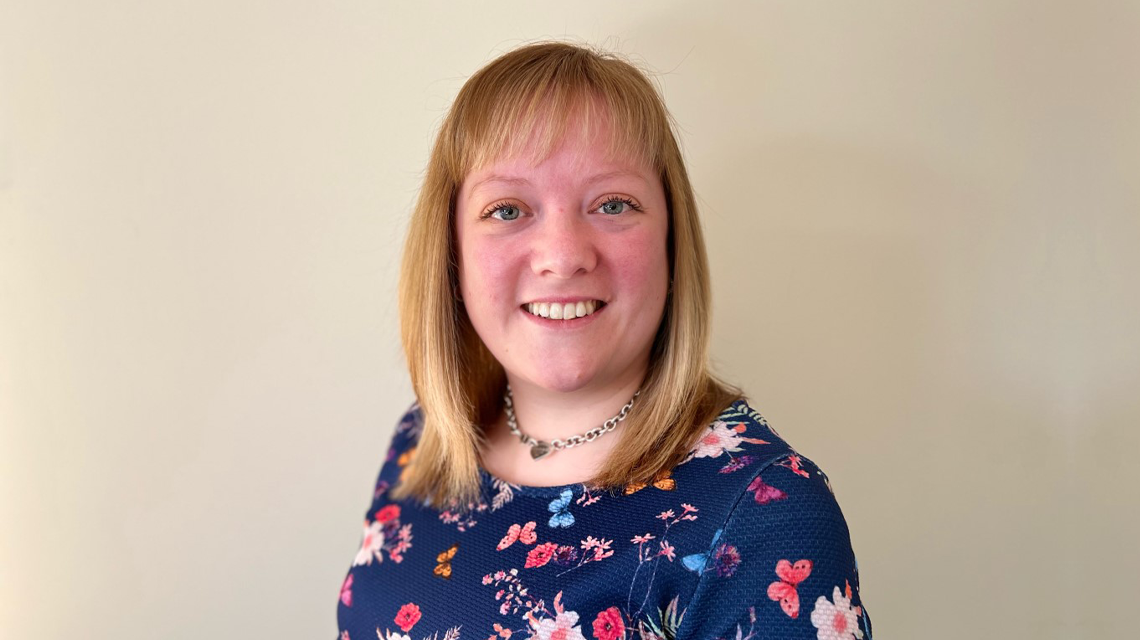Updates to GCSE (2024) French, German and Spanish
We have made changes to our specifications which are minor and will not significantly impact teaching and learning.
In April 2025 we communicated that the Department for Education had made updates to the Subject Content, which were published in February 2025.
We have made changes to our specifications in response to these updates which are minor and will not significantly impact teaching and learning.
In addition, and in response to teacher feedback, we have made some improvements to our specification and SAMs, to provide additional clarity and further improve accessibility for students.
We have also made small changes to three other areas, in addition to the DfE-driven amendment, to improve accessibility:
- Clarity on the number of timeframes required for each band in AO3
- Clarity on the difference between minor and major errors in AO3
- Increased accessibility of question formatting in the SAMs
All the changes above have been approved by Ofqual.
A full set of updated SAMs will be made available before the end of the summer term along with a new issue of the specification. An updated version of the interactive vocabulary tool will also be published later.
Specification Changes
Minor changes have been made to the vocabulary and grammar requirements of the specification. These changes, made in response to the Department for Education’s updates, are designed to provide additional clarity to teachers; equip students with the grammatical knowledge to be able to say what they want to say; and facilitate our writing of effective, engaging exam questions.
Key changes include:
A few of the requirements that were previously reserved for Higher tier are now expected to be learnt at both tiers. Examples include:
- Plural reflexive pronouns in French and Spanish
- Dative plural nouns in German
- Infinitive constructions using prepositions ohne/statt … zu and um … zu in German
Words listed under one part of speech in the specification may now be used in other parts of speech when the meaning is equivalent. For example:
- French: dur was previously listed as both an adjective and an adverb.
- German: schwimmen was previously listed as both a verb and a noun.
- Spanish: demasiado was previously listed as both an adjective and an adverb.
In each case, these previously counted as two separate entries in our vocabulary list. They now count as only one entry.
A paragraph has been added to the beginning of the derivational morphology section of each specification to explain how these rules will be applied to words in the vocabulary lists.
All previous vocabulary and grammar requirements are still expected to be known, so everything that teachers have taught thus far remains valid. Certain vocabulary items are no longer listed separately because of the amendments to the grammar rules. For example, the German phrase ‘mit (meinen) Freunden’ was previously listed as a separate short phrase at Foundation tier; this has now been removed because the formation of dative plural nouns, which was previously only included at Higher tier, is now included at both tiers. Foundation students will therefore be able to know this phrase from its components which are all listed separately in the vocabulary list. This has allowed us to add a small number of new words to our vocabulary lists
We have published extracts from the specifications of the full vocabulary and grammar appendices with all additions highlighted. You may find these here:
Changes to Sample Assessment Materials
In response to teacher feedback, we have made some improvements to the AO3 mark scheme for writing and speaking, to provide additional clarity.
What teachers said
(Using Q3 Foundation/Q1 Higher of the writing paper as an example): Teachers asked for greater clarity on which band to place responses in for use of timeframes. For example, could students get into band 3-4 if they were not successful in using three timeframes, or must they be awarded a mark in the bottom band (1-2)? This was because both the top band (5) and the band below (3-4) used the same descriptor, i.e. successful use of ‘… past present and future timeframes.’
What we did
To make it clearer, we have amended the wording of the mark scheme. In the amended version, the top band (5) requires successful use of three timeframes and the band below (3-4) requires at least two timeframes. The level of success required is also stated in both cases. 'Different' has been removed from band 1-2, allowing for success with any timeframe, even one, to be rewarded in this band.
See the comparison below for an example of the wording changes (Q3F/1H, writing paper):
Old version:
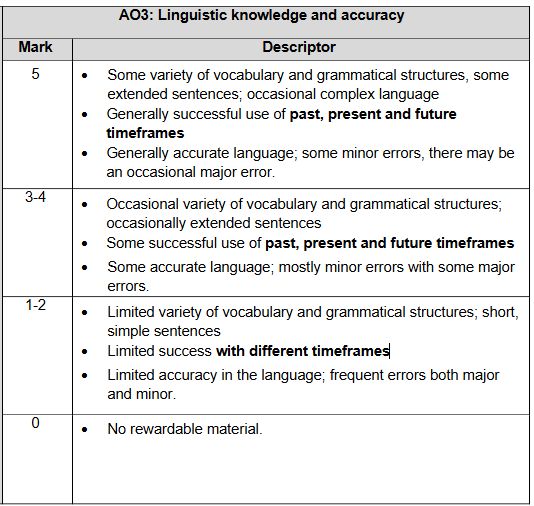
New version:
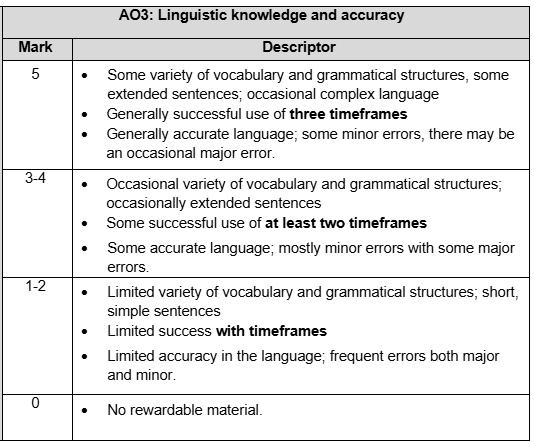
This change has been applied to all three languages and is relevant to the following questions/tasks:
- Writing paper – Q3 Foundation tier/Q1 Higher tier and Q2 Higher tier
- Speaking paper – Conversation at both tiers
A definition of ‘Timeframes’ has been added to the Glossary of terms: Timeframes refers to expressions of past, present and future. Various tenses can be used to express a timeframe. For example, the present tense in the following sentence is used to express a future timeframe: ‘I’m seeing my friends next week.’ In the following sentence a future tense is used to express a future timeframe: 'I will go to the cinema.’
What teachers said
Teachers asked for greater clarity on the difference between a minor and a major error.
What we did
In the original version of the guidance, the exemplification of ‘minor’ errors was split into two categories, ‘errors that do not hinder clarity’ and ‘errors that hinder clarity’. In the new version there is only one category for minor errors with one set of language-specific examples. A ‘minor’ error is now clarified as being ‘inaccurate but does not prevent meaning.’ A major error is now more clearly defined as one that is ‘inaccurate and prevents meaning.’
These changes help to differentiate between a ‘minor’ and a ‘major’ error and are applicable to French, German and Spanish. A full set of updated SAMs will be made available before the end of the summer term.
This change has been applied to all three languages and is relevant to the following questions/tasks:
- Writing paper – All questions except for Q1 Foundation tier
- Speaking paper – Picture task and Conversation at both tiers
In order to maximise accessibility of questions for students and in line with Ofqual’s guidance on designing and developing accessible assessments (part of Ofqual's handbook, General conditions of recognition), we have made some small improvements to some of the question formatting in our SAMs. These include:
Speaking paper: The two pictures in the picture task are now presented in portrait rather than landscape and are displayed on the left-hand side, with the instructions being placed on the right-hand side. This allows the pictures to be bigger and clearer and makes the instructions even easier to read, with the information presented in a larger space.
Example of new version:
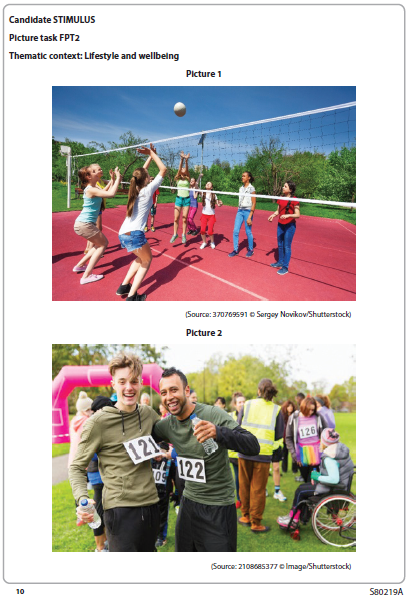
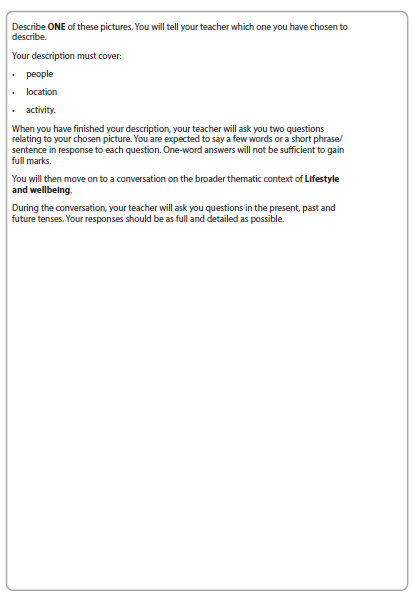
Reading paper: Any pictures within the paper are now displayed above the text rather than beside it. This enables students to read more easily from left to right and to focus on one thing at a time.
Example of new version:
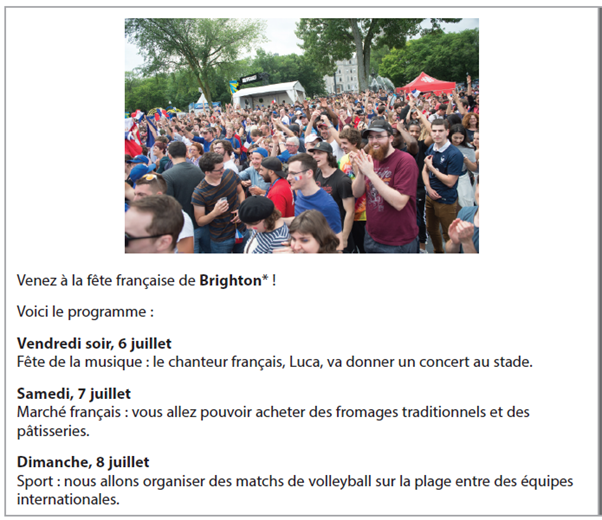
Translations, foundation tier, reading and writing papers: There are now two answer lines after each sentence rather than one, giving more writing space. This allows for crossings out and helps with general clarity of writing, for example for students who have larger handwriting.
Example of new version:

Subject advisor
Rebecca Waker
Languages
